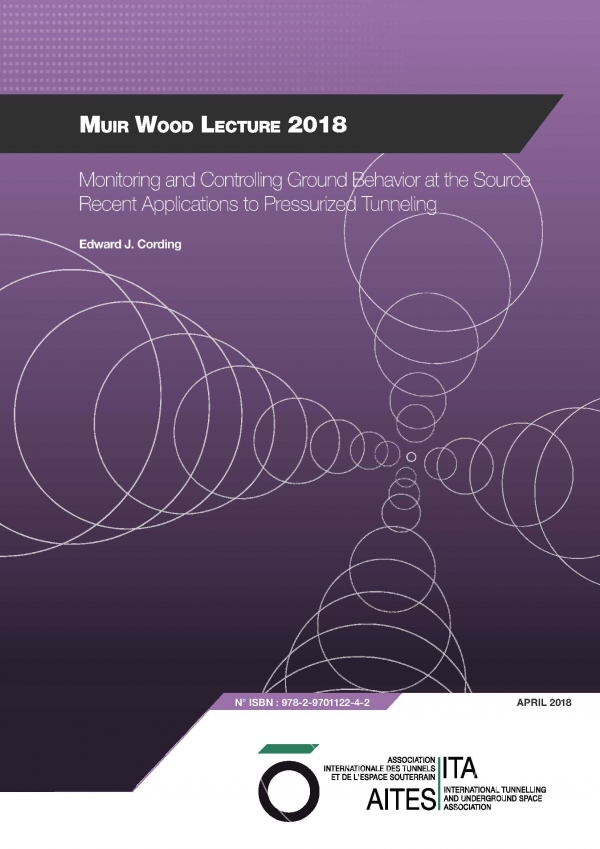presented are investigations and guidelines for monitoring, and controlling pressurized tunnel boring machines (TBMs) to prevent ground loss, and damaging settlement to structures. The process begins in the planning stages with the owner’s team and continues during construction with a coordinated program of managing, operating and monitoring the tunneling process. Monitoring of ground movements at their source is at the heart of the observational method for geotechnical projects. In large underground rock caverns and on slopes, borehole extensometers and inclinometers have been used for over 60 years to determine the depth of zones of movements and locate the geologic features affecting stability. In urban tunneling and excavation, these instruments are used to locate the sources of ground movement that could cause damaging settlement. For pressurized TBMs, such observations, made close to the advancing TBM, are key to understanding and controlling ground behavior. Examples are provided of earlier, open face shield tunneling where ground behavior could often be observed directly. The process often relied on the ability of the ground to stand unsupported, and the operator was provided with equipment with which he could not always be successful. The tunneling industry has witnessed a revolution. pressurized face TBMs- slurry balance machines and earth pressure balance machines (EpBMs) --- have enabled tunneling at greater depths under waterways and at shallower depths in urban areas without damaging settlement. advances in recent years have included the increasing capability to coordinate and control the TBM operation and monitor key machine functions and their impact on the surrounding environment in real time as the TBM advances. Maintaining and monitoring a continuously pressurized envelope of conditioned muck and injected slurries around the face and body of the shield, and grout around the lining at the tail of the shield have resulted in improved and consistent control of ground movements throughout the tunnel drive. In this paper, real time records of key TBM operating parameters are coupled with real time observations of ground movements and porewater pressures immediately around the advancing TBM. Borehole extensometers, piezometers, and directionally drilled horizontal inclinometers are used to pin-point the sources of ground movement and groundwater changes around the TBM to aid in making adjustments and confirming that ground control is being achieved. The results of such observations are described for both open face shields and pressurized face TBMs on tunneling projects in Washington, D.C, Chicago, Toronto, Seattle and los angeles. The benefits have been most dramatic in their application to large diameter TBMs and to TBMs driven at shallow depth in urban areas. The 17.5-m-diameter EpBM selected for the recently-completed tunneling for the alaskan Way Viaduct replacement project for State route 99 in Seattle was the largest pressurized TBM to be driven beneath an urban area. To assess and mitigate risks, the owner and contractor teams built on previous experience with large diameter pressurized face TBMs, including tunnels in porto (portugal), Barcelona, and Madrid driven with 9- to 15-m-diameter earth pressure balance machines (EpBMs). Ground improvement and reinforcement methods were implemented, but the primary and most effective ground control measures were in planning and executing the TBM operation. Continuous pressurization of the TBM face, shield steering gap, and lining gap at the shield tail prevented ground loss and prevented damaging settlement throughout the drive beneath Seattle structures. Essentially, such a tunneling operation achieves the objective described in an 1818 patent application for a tunnel shield by Marc Isambard Brunel of “opening… the ground in such a manner that no more earth shall be displaced than is to be filled by the shell or body of the tunnel” (Muir Wood, 1994, Skempton and Chrimes, 1994). For the 17.5-m EpBM, the settlements immediately above the shield were smallest when the tunnel was at shallow depth, and there was no surface settlement. The results were the opposite of calculations based on an assumed percentage of ground loss, which show the largest settlements and potential damage to structures occur when the tunnel is at shallow depth. That can lead to prescribing ground modification measures or adjusting the alignment to satisfy the assumption, rather than placing primary emphasis on preventing the ground loss by controlling the tunneling operation. recent progress has made reliable prevention of ground loss possible with the real time linkage of TBM operating parameters and geotechnical observations. It is of critical importance that there be a coordinated effort among TBM operation and geotechnical monitoring, supervision, engineering, data management, safety, and construction management to assess and mitigate risks, and monitor and control the tunneling operation. Examples of such efforts are provided. Consistently controlling pressures and minimizing settlement throughout the tunnel drive serve as a demonstration to project participants and the community alike that structures along the tunnel alignment will be protected.
